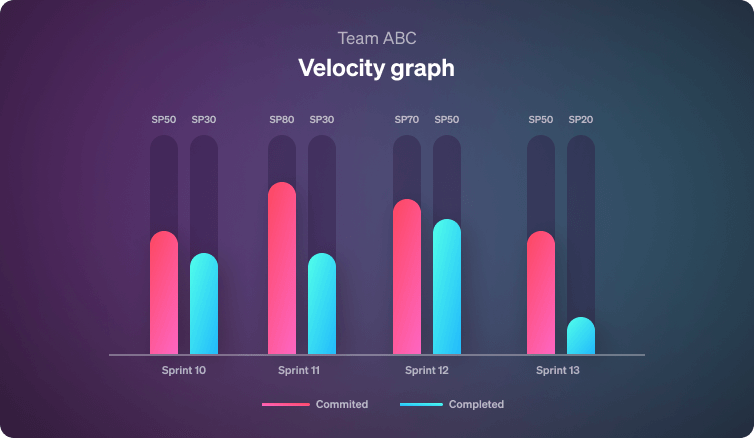
Are you a project manager or a team lead who always dreams of getting more from your team? This is one of the goals of any software professional who has a product growth mindset.
The famous business quote: “If you can’t measure it you can’t improve it.” ~ Drucker is equally applicable for software development. There are various indicators that can be used to measure the productivity of your software development team. One of these indicators is Software Development Velocity.

Even if you have already seen velocity graphs in software development, you may not be familiar with Software Development Velocity.
The term “velocity” in software development defines the rate at which a software engineering team delivers work. In simple terms, if the velocity figure is higher, this means that the team does more work within a given period of time.
Specific to a team, Software Development Velocity is an effective metric to predict product delivery. Therefore, it is crucial to get the measuring of the velocity right.
There are two main methods available to measure this:
This Software Development Velocity metric is one of the best indicators of the progress of a software product, which is helpful to predict software release timelines. Suppose a software development team is not analyzing what they committed and what they actually completed for previous sprints. In that case, it makes accurate project planning nearly impossible.
Other than the improved predictability, there are many more advantages of tracking Software Development Velocity. These include gaining a deeper understanding about the team and their performance level, being able to set realistic expectations for stakeholders of the project and detecting infrastructural and process limitations.
Here comes the big question! There are some tried-and-tested ways that successful team leads use to increase their team’s velocity. Let’s look at some of the best ones out there.
The simple formula to boost your team’s productivity is to get high-quality work done in a shorter time. For this, your team should have the right tools.
Modern software development incorporates software that helps improve productivity. Machine learning based tools are at the forefront of boosting productivity not just for developers but for all company functions.
By using AI tools for day-to-day software development work, undoubtedly, team productivity can be increased, which will ultimately boost team velocity.
Tabnine’s AI Assistant is one of the most effective tools for increasing Software Development Velocity. Tabnine provides AI-based code completions for you and your development team that boost productivity, supports almost all languages, and is FREE.
Watch this YouTube video to see TabNine in action.
At a glance, this may sound like a conflicting statement. However, focussing on higher quality outputs has proven to translate into a more significant return on investment, making higher velocity figures in the long run.
Time is an extremely valuable resource when it comes to developing software. Every team lead wants to build software as fast as possible, but rushing projects can cause more harm than good. Not only that, it also leaves your team feeling completely burned out and unmotivated.
Instead, make your meetings productive, improve the efficiency of code reviews and do peer testing systematically to ensure better quality products.
If you have an unhappy team, it doesn’t matter how many processes you implement or how many project management tasks you perform. You will always see a lower velocity figure.
Suppose you are a team leader who is always trying to increase delivery by micromanaging your team. Putting too much pressure on your team can create a negative working environment and potentially even make a higher turn-over rate.
Therefore, it is crucial to focus on the well-being of your team and to give your time and attention to understand your team members’ concerns. Equally important is to ensure that your team has the right educational resources should they wish to expand their skills or specialise in a particular topic. This will make them feel much more empowered and confident at work, and ultimately increase their productivity.
When you take care of your team, they will take care of the product.
Never try to manage your team too much; instead, let each team member take ownership of the areas that they really master. Make them feel that they are part of a bigger cause. Once they realize their own potential and the impact they can have in the company’s success, they will put in their best efforts.
Meanwhile, do not forget to cheer and celebrate the team’s success. Organize team outings, casual chats, and occasional surprise gifts and perks to keep the team engaged. Also, having open discussions regarding career progress and compensation is a great way to motivate the team to continue to do well.
The team’s velocity is highly coupled with the team’s composition. If you have to change your team members frequently, this is probably slowing the velocity down. However, realistically, you can’t guarantee the same team to remain together forever. That is why it is extremely important to have a plan B.
Maintaining a Knowledge Management System (KMS) helps you to pass all the relevant information on to new team members, ensuring that they can keep up-to-date with all practices and systems as soon as possible. In your KMS you can document best practices, specifications, and implementation details of product functionalities and architectural designs. If a team member decides to resign, their product expertise should remain with the team. It should be easily transferable to a newcomer as efficiently as possible with a proper KMS.
You should also resource a replacement as quickly as possible. Finding the right talent is extremely difficult, yet you can mitigate the risk of running low on human resources if you already have a talent pool of software developers that you can reach out to.
The Software Development Velocity metric can be an efficient way for you to analyse how your team works and what can be improved. Now that you have a deeper understanding of this metric, how it is measured and its importance, you can use some of the suggestions presented in this article to increase your team’s productivity and ultimately achieve a higher Software Development Velocity.